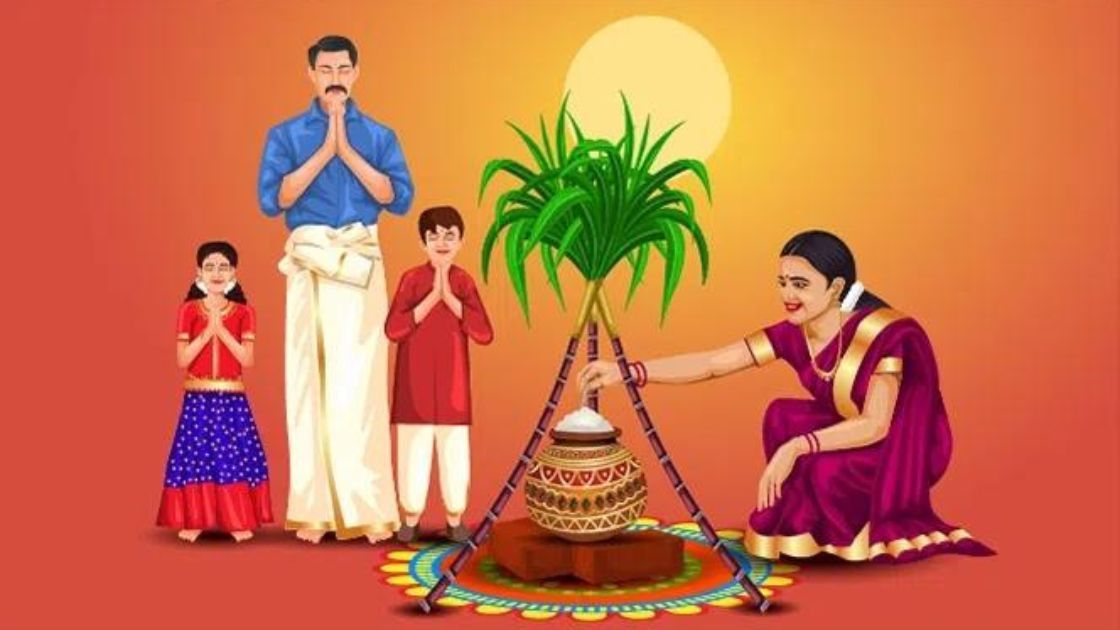Rituals and Celebrations of Pongal

- Pongal is a South-India festival celebrated in various parts of the country in different ways. It is a Hindu festival of joy and fulfillment which generally falls on the Gregorian date of January 14th or 15th.
- Sankranthi is a festival of harvest. It is dedicated to the glory of the Surya – Hindu deity (Sun God). This season/time marks the end of the cold winter season and the beginning of the spring season with good harvests.
- This festival is also known as the harvest festival, as the farmers show gratitude towards God for the harvest. Pongal is a 3-day celebration where each day owns its significance.
- Pongal has a variety of names, one of which is Makar Sankranti or Sankranthi. It is known as so in the states like Maharashtra, Uttar Pradesh, Telangana, Andhrapradesh, and a few other states.
- On the day of Sankranthi or Pongal, the farmers celebrate the newly harvested crop. When the Sun enters the sign of Capricorn, it is considered that the sun shines in every human body illuminating the six chakras (spiritual centers).
- Two of the most important chakras are the heart (hridaya) chakra and the crown chakra (Sahasrara chakra). The heart chakra consists of eight petals. These eight petals resemble the eight consorts of the Lord. The solar system is derived from the Sun and is worshipped as divine.
As Makar Sankranti is an auspicious day, most Hindus pray to get the blessings of the Sun God (Surya) by doing the following:
- They take a holy dip in the waters of Ganges, Yamuna, Krishna, and Godavari
- Carrying out Surya Namaskar or sun salutation early in the morning before starting the day.
- Offering the Sun God with cow’s milk in copperware.
- Preparing traditional dishes and sweets. This traditional Sankranthi food includes Halwa, Puran Poli, Makar Chaula, Pinni, Pongal, and many more.
Another popular belief is that exposure to the sun while flying kites on this auspicious day of Sankranthi will burn the germs and detoxify the body. Melas or fairs are organized in some states like Uttar Pradesh and Odisha which play an integral part in Makar Sankranti. Kumbh Mela is one of the most famous fairs.
In some Indian states like Andhra Pradesh, Telangana, Karnataka, and Maharashtra the festival lasts for around three days.
First Day – Bhogi
- It is celebrated just for a day and before the main festival of Sankranthi. This day is celebrated in the form of Bhogi Mantalu (Bhogi bonfires). Where we burn the old agricultural wastes and household articles that aren’t of any use. This resembles our rejoice for the coming of the new harvest season.
- Bhogi is also celebrated by drawing Kolam designs or colorful rangoli outside and inside the houses. People are also found giving or exchanging sweets or delicacies with their neighbors and their friends around them. Most importantly, farmers and all others seek the blessings of Lord Indra for a good harvest and prosperity throughout the year.
Second day – Sankranti
- The second day of the festival is Sankranthi which is a solar event. This is the time when there is a movement of the Sun god to Capricorn. This is the reason, Sankranti is also known as Uttarayana, as on this day the sun begins its journey towards the North.
- This day is considered to be a great day to perform spiritual practices. On this day, people take a dip at Sangam – the junction of the holy rivers Ganga and Jamuna. Also, on this day the floors in front of all the houses are beautifully decorated and designed with rangolis made from colorful sand, rice, or flowers. Also, most people enjoy flying kites on this day.
Third day – Kanuma
- The three-day celebrations come to an end with Kanuma on the third day after the main festival. Kanuma is the festival of cattle. Since bulls play an important role, the cattle are worshipped on this day for reaping good harvests in the future.
- This day is also known to resemble the day when Krishna lifts the Govardhan hillock with the little finger of his right hand to save the people of the village. Also, on this day, few people arrange bommala koluvu which is an arrangement of various Hindu deities and dolls.
- This plays an important role in educating the children about the culture and traditions that are being followed for generations.
- The fourth day of the festival, which is celebrated by fewer people, is known as Mukkanuma. Mukkanuma is the following day of Kanuma and is considered to resemble prosperity. These days, Kanuma and Mukkanuma are when people enjoy having a feast on meat dishes.
- Pongal or Sankranthi is the festival that best showcases the culture and traditions of South India. This makes it the best time to visit the states and enjoy the festivities. Also, South India has a diverse food range that must be tested by one. Read the following article for some amazing Pongal recipes.
Related Links
Keywords: Celebration of Pongal, Celebration of Sankranthi, Celebration of Pongal festival, 3 days of Pongal, 3 days of Sankranthi, Rituals of Sankranthi, Rituals of Pongal.

